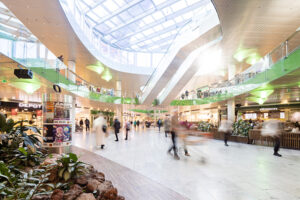By Alexander Otto, CEO of ECE
I’m certainly following the shift currently underway in the market very closely. But view this change as an opportunity: If a player like Amazon can evolve, why can’t shopping centers, which have been known for their flexibility, do the same?
In my view, the shopping center of the future is a platform that is home to both “classic” brick-and-mortar retail and e-commerce concepts. In addition to being a shopping and leisure destination, it will also be a logistics center and a manufacturing facility.
This idea is not entirely new: Shopping centers’ customers should see them as “third places,” i.e. a favorite place outside their homes and workplaces with a high quality of stay. The customer of the future will be connected analogically and digitally with the center in every respect. To this end, we at ECE have been testing the “Digital Mall” at Alstertal-Einkaufszentrum (AEZ) in Hamburg since 2016.
It is a digital version of the shopping center that lists the products on sale in the center, shows their availability, and lets customers reserve them. Technical reasons current mean that not all retailers can take part in the project, but 100,000 products are already available online.
It is only a matter of time until we can present the center’s entire product range online. In doing this, we are also looking beyond our own world and we have already been in talks with online players regarding potential business collaborations. This has stimulated the interest of all parties involved.
In the future, customers will no longer differentiate between online and offline retail. They will be able to order a product online and check it out in the center or buy it in the center and have it delivered their homes. There will be services like trunk delivery, whereby a robot delivers the shopping to the customer’s car. It will also be possible to have products delivered directly from the center. The shopping center will thus serve a dual purpose: It will be a shopping destination for customers and a logistics platform.
Here we have a considerable advantage over “classic” online retailers: Our industry comprises approximately 500 shopping centers in Germany that can reach large parts of the population within 30 minutes. In addition, centers are large storage facilities that can make the “last mile” of the delivery chain to the customer’s home significantly shorter and allow for faster delivery times. Already today, returns can be handled faster and more conveniently in many shops than by postal services.
But the shopping center of the future will not be just a commercial or a logistics property. It will also become a manufacturing facility. There is a trend among customers towards asking for customized products that can be produced in the centers of the future, e.g. with body scanners and 3D printers. Moreover, digitalization will impact other areas: Automatic checkouts, automatic cashless payments, robot shop assistants, tailored offers sent to the customers’ smartphone, and augmented-reality goggles will shape the shopping experience of the future.
We know many of these services as mere prototypes today, but I’m sure that they will become normal to us in a few years. That will allow the “shopping center” platform to continue to be very successful.





